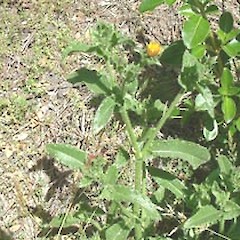Helminthotheca echioides
Common name
Oxtongue
Family
Asteraceae
Flora category
Vascular – Exotic
Structural class
Herbs - Dicotyledonous composites
NVS code
The National Vegetation Survey (NVS) Databank is a physical archive and electronic databank containing records of over 94,000 vegetation survey plots - including data from over 19,000 permanent plots. NVS maintains a standard set of species code abbreviations that correspond to standard scientific plant names from the Ngä Tipu o Aotearoa - New Zealand Plants database.
HELECH
Conservation status
Not applicable
Habitat
A common weed of waste land, pasture, urban areas, and forest margins. Coastal to montane.
Wetland plant indicator status rating
Information derived from the revised national wetland plant list prepared to assist councils in delineating and monitoring wetlands (Clarkson et al., 2021 Manaaki Whenua – Landcare Research Contract Report LC3975 for Hawke’s Bay Regional Council). The national plant list categorises plants by the extent to which they are found in wetlands and not ‘drylands’. The indicator status ratings are OBL (obligate wetland), FACW (facultative wetland), FAC (facultative), FACU (facultative upland), and UPL (obligate upland). If you have suggestions for the Wetland Indicator Status Rating, please contact: [Enable JavaScript to view protected content]
UPL: Obligate Upland
Rarely is a hydrophyte, almost always in uplands (non-wetlands).
Similar taxa
The stem and leaf indumentum of oxtongue (Helminthotheca echioides (L.) Holub) has 2-, 3-, 4- or 5-hooked anchor hairs and the hairs of the leaves arise from a conspicuous swollen base. The involucral bracts of the flowers are in two rows, with the five outer involucral bracts ovate to cordate, and the apex of the inner bracts feather-like. Unlike our indigenous oxtongus (Picris spp. ) the achenes of the introduced oxtongue (H. echioides) are dimorphic: the outer achenes, are larger, white, and pilose hairy; the inner shorter, dark-brown and glabrous. In our indigenous oxtongues (Picris spp.) the achenes are never heteromorphic.
Flowering
Year round in warm climates - otherwise August - May
Flower colours
Red/Pink, Yellow
Fruiting
Present year round in warm climates otherwise October - July
Year naturalised
1869
Origin
S. Europe, S.W Asia, N. Africa - long known in New Zealand as Picris echioides L.
Reason For Introduction
Probably accidental
Life Cycle Comments
Biennial to short-lived perennial. Sometimes annual in harsh conditions.
Reproduction
Exclusively by seed
Seed
Dimorphic. Outer achenes are white and larger than the brown inner achenes. Seed is probably long-lived as this species turns up in agricultural grassland soil that has been recently ploughed
Dispersal
Wind dispersed. The seeds also attach to clothing, wool and other fibres
Tolerances
Moderately drought and cold tolerant.


















